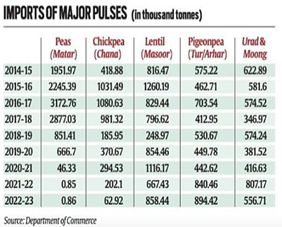

5th June 2023 (8 Topics)
Context
As per the information India is building its pulses production capacity as compared to Edible oils, which both are the significantly import-dependent goods.
About
- The reduction in pulses imports have come essentially on the back of higher domestic production.
- According to the Agriculture Ministry, India’s pulses output has increased from 19.26 mt in 2013-14 to 27.50 mt in 2022-23.
- Private trade estimates of production are lower at 23-24 mt.
- Even taking 23 mt production and 2.5 mt imports translates into an atmanirbharta or self-sufficiency ratio of over 90% in pulses, as against hardly 40% for edible oils.


Pulses imports vs. Edible Oils:
|
|
Government Initiatives:
- To increase the production of pulses the National Food Security Mission-Pulses programme is being implemented in 644 districts of 28 States and Union Territories (UTs) of Jammu & Kashmir and Ladakh.
- Under NFSM-Pulses, incentives are given to the farmer for cluster demonstration, seeds distribution & production of certified seeds of High Yielding Varieties (HYVs), farm machineries/tools, and efficient water saving devices, plant protection chemicals, nutrient management, soil ameliorants and training to the farmers.
More Articles



